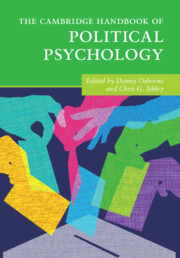Book contents
- The Cambridge Handbook of Political Psychology
- The Cambridge Handbook of Political Psychology
- Copyright page
- Dedication
- Contents
- Figures
- Tables
- Contributors
- Part I Foundations of Political Psychology
- Part II The Politics of Intergroup Attitudes
- 11 Authoritarianism
- 12 A Political Psychology of Ethnocentrism
- 13 Collective Narcissism
- 14 Demographic Change, White Decline, and the Changing Nature of Racial Politics in Election Campaigns
- 15 Macro-diversity and Intergroup Attitudes
- 16 The Persistence of Gender in Campaigns and Elections
- 17 The Politics of Abortion, Pregnancy, and Motherhood
- 18 Religiosity and Openness to Authoritarian Governance
- 19 The Consequences of Moral Conviction in Politics
- 20 The Political Psychology of National Identity
- 21 The Political Dynamics of Immigration Opinion Worldwide
- 22 International and Individual Differences in Support for Human Rights
- Part III Contemporary Challenges to Democracy
- Part IV Diversifying Perspectives in Political Psychology
- Index
- References
20 - The Political Psychology of National Identity
from Part II - The Politics of Intergroup Attitudes
Published online by Cambridge University Press: 17 February 2022
- The Cambridge Handbook of Political Psychology
- The Cambridge Handbook of Political Psychology
- Copyright page
- Dedication
- Contents
- Figures
- Tables
- Contributors
- Part I Foundations of Political Psychology
- Part II The Politics of Intergroup Attitudes
- 11 Authoritarianism
- 12 A Political Psychology of Ethnocentrism
- 13 Collective Narcissism
- 14 Demographic Change, White Decline, and the Changing Nature of Racial Politics in Election Campaigns
- 15 Macro-diversity and Intergroup Attitudes
- 16 The Persistence of Gender in Campaigns and Elections
- 17 The Politics of Abortion, Pregnancy, and Motherhood
- 18 Religiosity and Openness to Authoritarian Governance
- 19 The Consequences of Moral Conviction in Politics
- 20 The Political Psychology of National Identity
- 21 The Political Dynamics of Immigration Opinion Worldwide
- 22 International and Individual Differences in Support for Human Rights
- Part III Contemporary Challenges to Democracy
- Part IV Diversifying Perspectives in Political Psychology
- Index
- References
Summary
National identity represents one of the most central and defining group identities in the modern world with important implications in everyday life. In the current chapter, we review the extant literature from political psychology on nationhood by considering two key dimensions of national identity: (a) identification and attachment; and (b) its content. First, we explore the vast literature on national identification, and consider two forms of national attachment (patriotism and nationalism) alongside its societal implications. Within this focus, we consider national identification and disidentification and its consequences among majority, minority, and immigrant groups. We then review the political psychology literature on the content and meaning of nationhood by distinguishing between ethnic and civic national character, consider its societal implications, and consider research on implicit and explicit psychological representations of nationhood. We conclude by highlighting some key directions for future research on national identity within political psychology.
- Type
- Chapter
- Information
- The Cambridge Handbook of Political Psychology , pp. 311 - 328Publisher: Cambridge University PressPrint publication year: 2022
References
- 3
- Cited by



